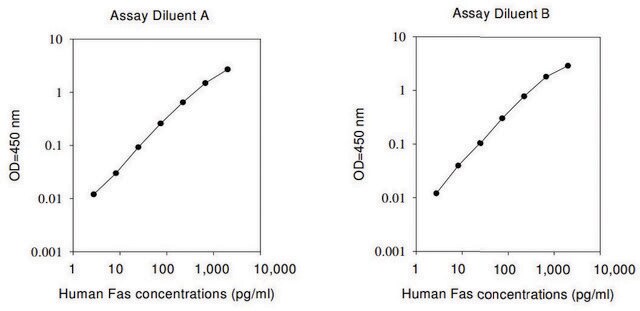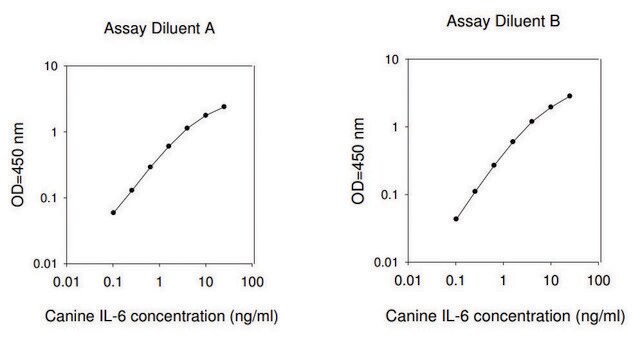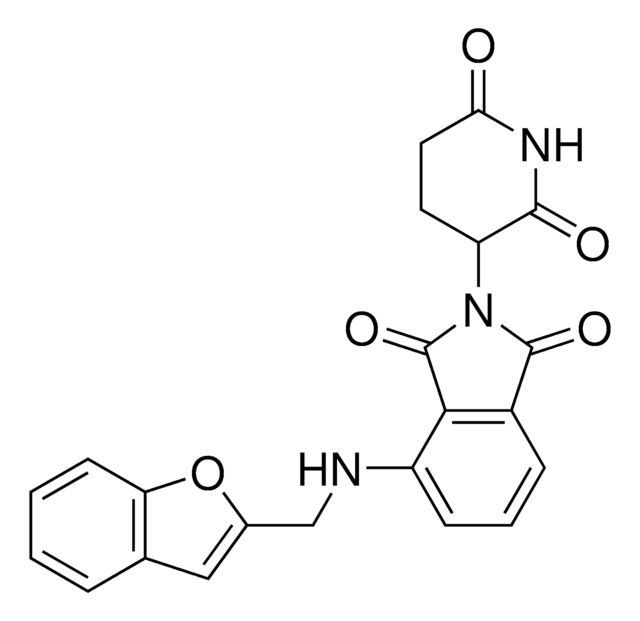RAB0178
Human Fas Ligand ELISA Kit
for serum, plasma, and cell culture supernatants
Sinónimos:
FasL
Iniciar sesiónpara Ver la Fijación de precios por contrato y de la organización
About This Item
Código UNSPSC:
41116158
NACRES:
NA.32
Productos recomendados
reactividad de especies
human
envase
kit of 96 wells (12 strips x 8 wells)
técnicas
ELISA: suitable
capture ELISA: suitable
entrada
sample type plasma
sample type serum
sample type cell culture supernatant(s)
assay range
inter-assay cv: <12%
intra-assay cv: <10%
sensitivity: 2 pg/mL
standard curve range: 1.37-1000 pg/mL
método de detección
colorimetric
Condiciones de envío
wet ice
temp. de almacenamiento
−20°C
Información sobre el gen
human ... FASLG(356)
Descripción general
The Human Fas Ligand ELISA (Enzyme-Linked Immunosorbent Assay) kit is an in vitro enzyme-linked immunosorbent assay for the quantitative measurement of human Fas Ligand in serum, plasma, cell culture supernatants and urine.
Inmunógeno
Recombinant Human Fas Ligand
Aplicación
For research use only. Not for use in diagnostic procedures.
Please refer to the attached General ELISA KIT Procedure (sandwich, competitive & Indirect ELISA)
Please refer to the attached General ELISA KIT Procedure (sandwich, competitive & Indirect ELISA)
Acciones bioquímicas o fisiológicas
Binding of Fas Ligand (FasL) to Fas receptor triggers apoptosis in Fas-bearing cells. FasL has the ability to kill T cells and activate B cells which leads to down-regulation of the immune response. The mechanism of Fas induced apoptosis involves recruitment of pro-caspase 8 through an adaptor molecule called FADD (Fas-associated protein with death domain) followed by processing of the pro-enzyme to active forms. These active caspases then cleave various cellular substrates leading to eventual cell death. FasL is also involved in AGE (advanced glycation end-product)-mediated apoptosis in human retinal ARPE-19 cells, suggesting its role in diabetic retinopathy. Changes in the activity of FasL suppress normal apoptosis, leading to abnormal survival and growth of tumor cells. Mutations in the FasL gene causes autoimmune lymphoproliferative syndrome (ALPS).
Otras notas
A sample Certificate of Analysis is available for this product.
Please type the word sample in the text box provided for lot number.
Please type the word sample in the text box provided for lot number.
Los componentes del kit también están disponibles por separado
Referencia del producto
Descripción
SDS
Palabra de señalización
Warning
Frases de peligro
Consejos de prudencia
Clasificaciones de peligro
Met. Corr. 1
Código de clase de almacenamiento
8A - Combustible corrosive hazardous materials
Elija entre una de las versiones más recientes:
¿Ya tiene este producto?
Encuentre la documentación para los productos que ha comprado recientemente en la Biblioteca de documentos.
W C Powell et al.
Current biology : CB, 9(24), 1441-1447 (1999-12-23)
The Fas ligand/Fas receptor (FasL/Fas) system is an important mediator of apoptosis in the immune system where the juxtaposition of cells expressing the cell-surface ligand induces the apoptotic pathway in Fas-expressing lymphocytes. The FasL/Fas system has also been shown to
M R Alderson et al.
The Journal of experimental medicine, 181(1), 71-77 (1995-01-01)
A significant proportion of previously activated human T cells undergo apoptosis when triggered through the CD3/T cell receptor complex, a process termed activation-induced cell death (AICD). Ligation of Fas on activated T cells by either Fas antibodies or recombinant human
Yin Li et al.
International journal of clinical and experimental pathology, 8(9), 11915-11920 (2015-12-01)
To investigate the relation of Fas and Fas ligand (FasL) protein expression with carcinogenesis and metastasis of cardiac carcinoma. Immunohistochemistry was used to detect Fas and FasL protein expression in 64 cardiac carcinoma tissue samples and 20 normal gastric tissue
Pu Wang et al.
Bioscience, biotechnology, and biochemistry, 80(2), 250-256 (2015-10-20)
Advanced glycation end-products (AGEs) are extremely accumulated in the retinal vascular and epithelial cells of diabetes mellitus (DM) patients, particularly with diabetic retinopathy (DR). To elucidate the pathogenesis of the AGE-induced toxicity to retinal epithelial cells, we investigated the role
Ignatios Ikonomidis et al.
Circulation. Cardiovascular imaging, 7(4), 619-628 (2014-05-02)
We investigated the effects of anakinra, an interleukin-1 receptor antagonist, on coronary and left ventricular function in coronary artery disease (CAD) patients with rheumatoid arthritis. In a double-blind crossover trial, 80 patients with rheumatoid arthritis (60 with CAD and 20
Nuestro equipo de científicos tiene experiencia en todas las áreas de investigación: Ciencias de la vida, Ciencia de los materiales, Síntesis química, Cromatografía, Analítica y muchas otras.
Póngase en contacto con el Servicio técnico







